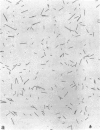Abstract
The dissolution rate of glass fibers has been shown to be pH sensitive using in vitro lung fluid simulant models. The current study investigated whether there is a difference in phagosomal pH (ppH) between rat alveolar macrophages (AM) and rat nasal epithelial cells (RNEC) and whether such a difference would influence the dissolution of glass fibers. The ppH was measured in cultured AM and RNEC using flow cytometric, fluorescence-emission rationing techniques with fluorescein-labeled, amorphous silica particles. Glass fiber dissolution was determined in AM and RNEC cultured for 3 weeks with fast dissolving glass fibers (GF-A) or slow dissolving ones (GF-B). The mean diameters of GF-A were 2.7 microns and of GF-B, 2.6 microns, the average length of both fibers was approximately 22 to 25 microns. Dissolution was monitored by measuring the length and diameter of intracellular fibers and estimating the volume, assuming a cylindrical morphology. The ppH of AM was 5.2 to 5.8, and the ppH of RNEC was 7.0 to 7.5. The GF-A dissolved more slowly in RNEC than in AM, and no dissolution was evident in either cell type with GF-B. The volume loss with GF-A after a 3-week culture with AM was 66% compared to 45% for cultured RNEC. These results are different from those obtained using in vitro lung fluid-simulant models where dissolution is faster at higher pH. This difference suggests that dissolution rates of glass fibers in AM should not be applied to the dissolution of fibers in epithelial cells.
Full text
PDF





Images in this article
Selected References
These references are in PubMed. This may not be the complete list of references from this article.
- Brody A. R., Hill L. H., Adkins B., Jr, O'Connor R. W. Chrysotile asbestos inhalation in rats: deposition pattern and reaction of alveolar epithelium and pulmonary macrophages. Am Rev Respir Dis. 1981 Jun;123(6):670–679. doi: 10.1164/arrd.1981.123.6.670. [DOI] [PubMed] [Google Scholar]
- Brody A. R., Roe M. W., Evans J. N., Davis G. S. Deposition and translocation of inhaled silica in rats. Quantification of particle distribution, macrophage participation, and function. Lab Invest. 1982 Dec;47(6):533–542. [PubMed] [Google Scholar]
- Cole R. W., Ault J. G., Hayden J. H., Rieder C. L. Crocidolite asbestos fibers undergo size-dependent microtubule-mediated transport after endocytosis in vertebrate lung epithelial cells. Cancer Res. 1991 Sep 15;51(18):4942–4947. [PubMed] [Google Scholar]
- Corrin B. Phagocytic potential of pulmonary alveolar epithelium with particular reference to surfactant metabolism. Thorax. 1970 Jan;25(1):110–115. doi: 10.1136/thx.25.1.110. [DOI] [PMC free article] [PubMed] [Google Scholar]
- Haugen A., Schafer P. W., Lechner J. F., Stoner G. D., Trump B. F., Harris C. C. Cellular ingestion, toxic effects, and lesions observed in human bronchial epithelial tissue and cells cultured with asbestos and glass fibers. Int J Cancer. 1982 Sep 15;30(3):265–272. doi: 10.1002/ijc.2910300303. [DOI] [PubMed] [Google Scholar]
- Jaurand M. C., Gaudichet A., Halpern S., Bignon J. In vitro biodegradation of chrysotile fibres by alveolar macrophages and mesothelial cells in culture: comparison with a pH effect. Br J Ind Med. 1984 Aug;41(3):389–395. doi: 10.1136/oem.41.3.389. [DOI] [PMC free article] [PubMed] [Google Scholar]
- Jaurand M. C., Kaplan H., Thiollet J., Pinchon M. C., Bernaudin J. F., Bignon J. Phagocytosis of chrysotile fibers by pleural mesothelial cells in culture. Am J Pathol. 1979 Mar;94(3):529–538. [PMC free article] [PubMed] [Google Scholar]
- Johnson N. F., Hoover M. D., Thomassen D. G., Cheng Y. S., Dalley A., Brooks A. L. In vitro activity of silicon carbide whiskers in comparison to other industrial fibers using four cell culture systems. Am J Ind Med. 1992;21(6):807–823. doi: 10.1002/ajim.4700210604. [DOI] [PubMed] [Google Scholar]
- Kanapilly G. M. Alveolar microenvironment and its relationship to the retention and transport into blood of aerosols deposited in the alveoli. Health Phys. 1977 Feb;32(2):89–100. doi: 10.1097/00004032-197702000-00004. [DOI] [PubMed] [Google Scholar]
- Laman D., Theodore J., Robin E. D. Regulation of intracytoplasmic pH and "apparent" intracellular pH in alveolar macrophages. Exp Lung Res. 1981 May;2(2):141–153. doi: 10.3109/01902148109052310. [DOI] [PubMed] [Google Scholar]
- Li A. P., Hahn F. F., Zamora P. O., Shimizu R. W., Henderson R. F., Brooks A. L., Richards R. Characterization of a lung epithelial cell strain with potential applications in toxicological studies. Toxicology. 1983 Jul-Aug;27(3-4):257–272. doi: 10.1016/0300-483x(83)90022-7. [DOI] [PubMed] [Google Scholar]
- Morgan A., Holmes A., Davison W. Clearance of sized glass fibres from the rat lung and their solubility in vivo. Ann Occup Hyg. 1982;25(3):317–331. doi: 10.1093/annhyg/25.3.317. [DOI] [PubMed] [Google Scholar]
- Mossman B. T., Kessler J. B., Ley B. W., Craighead J. E. Interaction of crocidolite asbestos with hamster respiratory mucosa in organ culture. Lab Invest. 1977 Feb;36(2):131–139. [PubMed] [Google Scholar]
- Nyberg K., Johansson A., Camner P. Intraphagosomal pH in alveolar macrophages studied with fluorescein-labeled amorphous silica particles. Exp Lung Res. 1989;15(1):49–62. doi: 10.3109/01902148909069608. [DOI] [PubMed] [Google Scholar]
- Nyberg K., Johansson U., Johansson A., Camner P. Phagolysosomal pH and location of particles in alveolar macrophages. Fundam Appl Toxicol. 1991 Apr;16(3):393–400. doi: 10.1016/0272-0590(91)90080-n. [DOI] [PubMed] [Google Scholar]
- Scheule R. K., Holian A. Modification of asbestos bioactivity for the alveolar macrophage by selective protein adsorption. Am J Respir Cell Mol Biol. 1990 May;2(5):441–448. doi: 10.1165/ajrcmb/2.5.441. [DOI] [PubMed] [Google Scholar]
- Stanton M. F., Laynard M., Tegeris A., Miller E., May M., Kent E. Carcinogenicity of fibrous glass: pleural response in the rat in relation to fiber dimension. J Natl Cancer Inst. 1977 Mar;58(3):587–603. doi: 10.1093/jnci/58.3.587. [DOI] [PubMed] [Google Scholar]
- van Erp P. E., Jansen M. J., de Jongh G. J., Boezeman J. B., Schalkwijk J. Ratiometric measurement of intracellular pH in cultured human keratinocytes using carboxy-SNARF-1 and flow cytometry. Cytometry. 1991;12(2):127–132. doi: 10.1002/cyto.990120205. [DOI] [PubMed] [Google Scholar]








